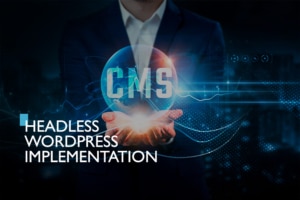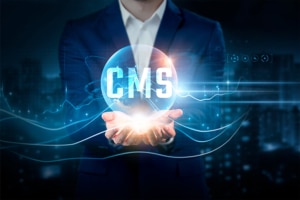Headless WordPress Implementation
Guide for B2B Performance
Years in Business
Completed Projects
Headless WordPress implementation represents a paradigm shift in how Southeast Wisconsin businesses approach their digital infrastructure. This decoupled architecture separates your content management system from the front-end presentation layer, enabling unprecedented flexibility and performance gains.
Recent studies show that B2B companies implementing headless CMS solutions experience 40% faster page load times and 2.3x improvement in conversion rates. For mid-sized firms navigating complex digital transformation initiatives, understanding this technology becomes essential for maintaining competitive advantage in increasingly demanding markets.

This separation enables businesses to maintain consistent content across multiple channels while optimizing each touchpoint for specific user experiences. According to Forrester Research, companies utilizing headless architectures report 35% reduction in development costs and 50% faster time-to-market for new features.
Wisconsin businesses face unique challenges with seasonal traffic fluctuations and diverse customer touchpoints across desktop, mobile, and emerging platforms. Headless implementation addresses these regional market dynamics by enabling automatic scaling during peak periods without compromising performance.
The decoupled nature allows development teams to work independently on front-end improvements while content creators continue managing their workflows uninterrupted. This parallel workflow structure proves particularly valuable for B2B firms managing complex product catalogs and multi-language requirements.
Successful headless WordPress deployment requires careful infrastructure planning and technology stack selection. Your implementation begins with choosing appropriate hosting solutions that support API-first architectures, with providers like Kinsta or WP Engine offering specialized headless configurations.
Front-end framework selection depends on your team’s expertise and project requirements, with Next.js, Gatsby, and Nuxt.js representing popular choices among enterprise implementations. Custom WordPress development expertise becomes crucial for configuring API endpoints, implementing authentication protocols, and establishing proper caching strategies.
Database optimization and CDN configuration form critical components of your headless infrastructure. Research indicates that properly configured CDN networks reduce global latency by 73% while decreasing server loads by 60%. Southeast Wisconsin companies serving national markets particularly benefit from edge caching strategies that position content closer to end users.
API rate limiting and security protocols must align with anticipated traffic patterns, preventing potential bottlenecks during high-demand periods. Performance monitoring tools like New Relic or Datadog provide essential insights for maintaining optimal system health.
Migrating existing WordPress installations to headless architectures requires systematic planning and phased execution approaches. Begin with comprehensive content audits identifying which elements require API exposure and which legacy features need replacement or elimination.
The migration process typically spans 12-16 weeks for mid-sized B2B platforms, though timeline varies based on content volume and integration complexity. Milwaukee Web Design professionals recommend starting with non-critical pages before transitioning core business functionalities.
Content modeling represents a foundational step often overlooked during headless transitions. Properly structured content types and relationships enable efficient API queries while maintaining flexibility for future expansions. Wisconsin businesses transitioning from traditional WordPress benefit from incremental migration strategies, maintaining existing functionality while gradually introducing headless components.
This approach minimizes disruption while allowing teams to validate performance improvements and adjust implementation strategies based on real-world metrics.
Headless WordPress implementations deliver exceptional performance improvements when properly optimized. Static site generation combined with incremental regeneration reduces server processing requirements by 85% while maintaining dynamic content capabilities.
B2B firms report average page load improvements from 3.2 seconds to under 800 milliseconds post-implementation. These performance gains directly correlate with improved search rankings and user engagement metrics, with Google’s Core Web Vitals favoring faster-loading sites.
Scaling headless infrastructures requires different approaches than traditional WordPress deployments. Horizontal scaling becomes more efficient when presentation and content layers operate independently, allowing targeted resource allocation based on actual usage patterns.
Milwaukee headless solutions benefit from auto-scaling configurations that respond dynamically to traffic surges. Cache invalidation strategies must balance content freshness with performance optimization, typically implementing tiered caching layers for different content types. Real-time analytics integration helps identify optimization opportunities while maintaining system stability during peak loads.

Key performance indicators include API response times, conversion rate improvements, and development velocity increases. Companies report 65% reduction in content publishing times and 3x improvement in multi-channel content distribution efficiency.
Long-term value propositions extend beyond immediate performance gains. Headless architectures enable rapid experimentation with emerging technologies without complete platform overhauls. Wisconsin businesses leveraging AI automation find headless platforms particularly advantageous for integrating machine learning capabilities.
The decoupled nature facilitates easier third-party integrations, reducing vendor lock-in concerns while maintaining flexibility for future innovations. Total cost of ownership typically decreases 30% over five-year periods compared to traditional monolithic architectures.
Strategic advantages manifest through improved market responsiveness and enhanced customer experiences. B2B buyers increasingly expect personalized, omnichannel experiences matching consumer-grade interfaces.
Headless implementations enable sophisticated personalization engines delivering content variations based on user behavior, industry vertical, and buying stage. Southeast Wisconsin headless implementations demonstrate particular success serving manufacturing and healthcare sectors requiring strict compliance and security standards.
Implementation timelines vary significantly based on organizational readiness and technical complexity. According to Storyblok’s State of CMS 2024 report, over 99% of companies switching to headless experienced improvements, with 61% reporting increased ROI.
Decision makers must evaluate current technical debt, team capabilities, and business objectives when planning migration timelines. Creating urgency around implementation becomes crucial as competitors increasingly adopt these technologies—early adopters in your industry sector gain sustainable advantages through superior user experiences and operational efficiencies that become increasingly difficult to match over time.
Implementation costs for mid-sized B2B firms typically range from $45,000 to $150,000, depending on complexity, content volume, and integration requirements. This includes infrastructure setup, migration, front-end development, and initial optimization phases.
Most mid-sized B2B migrations require 12-16 weeks from planning to full deployment. Phased approaches allow maintaining existing functionality while gradually transitioning to headless architecture, minimizing business disruption.
Next.js, Gatsby, and Nuxt.js represent the most popular choices for enterprise implementations. Framework selection depends on team expertise, performance requirements, and specific project needs. React-based solutions offer the largest ecosystem and community support.
Backend plugins continue functioning normally, but front-end dependent plugins require replacement with API-based alternatives. Content management, SEO, and security plugins typically work without modification, while display-oriented plugins need custom development.
Organizations typically see 40% faster page loads, 85% reduction in server processing, and page load times improving from 3.2 seconds to under 800 milliseconds. These improvements directly impact SEO rankings and conversion rates.
Web services are more than just website creation. They involve strategically crafting an experience that engages users, builds credibility, and turns your target audience into loyal customers.
Marketing goes beyond promoting products—it’s about telling a powerful brand story that builds trust, nurtures community, and drives meaningful business growth.
Book your no-obligation strategy session today and receive a complimentary custom homepage design. Limited to just 5 spots per month—reserve yours before they’re gone.

